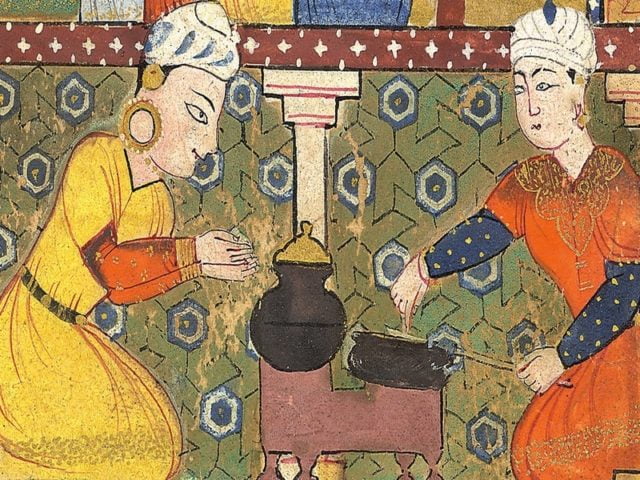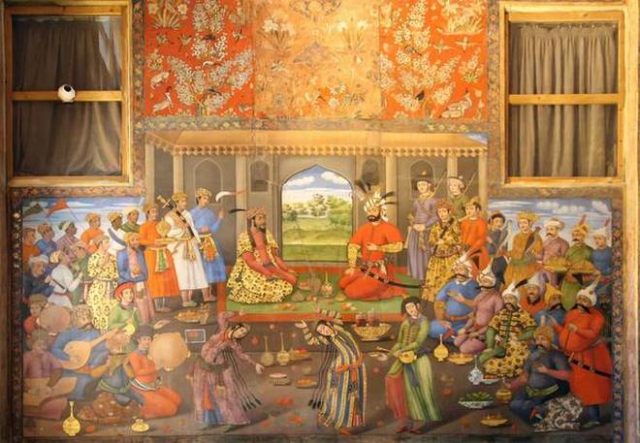Disclaimer: Originally published in September 2018. It is being republished since it still remains an interesting topic till today.
Well, its a holiday and on any given holiday my head is occupied with thoughts of delicious food. One particular weakness of mine has always been Mughlai food. Turns out that the emperors of the Mughal Dynasty loved their food and drinks too.
Of course, Jodha Akbar has taught us a thing or two. But cookbooks of Akbar, Shahjahan, and Aurangzeb take us closer to the history of Mughal cuisine.

The rich culinary delicacies Mughals left us with
Without a doubt, their food is lavish and extravagant in taste. The Mughals have been credited with creating sumptuous recipes in their royal kitchens which added aroma and colour to Delhi’s culinary range.
It was common for the shahikhansama (chief cook) to consult with the shahihakim (chief physician) while planning the royal menu to keep medical benefits in their diet. To aid digestion and act as an aphrodisiac each grain of rice in the biryani was coated with silver-flecked oil.
Flavour-wise, the royal cuisine was the mixture of the origins of the Mughal empire. Rich and complex flavours of Uzbekistan, Persia, Afghanistan, Kashmir and Punjab and Deccan were experimented together to perfect Mughlai cuisine.
Food also played an important role in political intercourse. The gift-sharing culture often conveyed messages of friendship, goodwill, status, and power.

Mughal emperors and their palate
It was Babur who first arrived with his love for Uzbekistan still intact. Not a big fan of Indian food, he was fascinated by the country’s cuisine and spices. He was used to eating log-cooked chicken and meat, beginning to improvise with Indian cuisine.
Humayun bought the essence of Persian food in the Mughal era. His love for Sherbet and other flavoured beverages with fruits made his Iranian wife Hamida introduce the lavish use of saffron and dry fruits in the royal kitchens.
Third in line, Akbar really evolved Mughlai cuisine into what it is now. Akbar was himself a vegetarian and even cultivated his own kitchen garden. His many marriages ensured his cooks came from all corners which fused Persian flavours with different cultural backgrounds of India.
Akbar’s son Jahangir was himself fond of eating and drinking and because of his wife, Nur Jahan Mughlai the cuisine continued to flourish.
At that time the royal court was presented with unique gifts from European nations with which Nur Jahan often made different wines, rainbow-coloured yogurt and candied fruit peels. But it was Jahangir’s heir under which Mughlai cuisine reached its peak.
Shah Jahan’s menu was an enlargement that was devised by his father and grandfather. More haldi, jeera and dhania in royal recipes was his way to keep medical properties intact.
Some popular stories recount how Mumtaz Mahal combined meat and rice to provide balanced nutrition to the soldiers, giving birth to our all-time favourite biryani and other explaining the origins of nihari, a spicy meat stew.
Also Read: Why Was Nepal Never Invaded By The Mughals?
The shift to south
It was during Aurangzeb’s time that Mughlai food got toned down as Aurangzeb fancied vegetarian dishes like the aforementioned panchmel dal, unlike his ancestors who preferred meat.
An elaborate biryani, Qubooli made with rice, basil, Bengal gram, dried apricot, almond, and curd also held a place of pride on the dining table of Aurangzeb.
As the hubs of the Mughal empire started shifting towards Hyderabad and Lucknow from those in Agra and Delhi, the amalgamation of culinary habits of Mughal and Deccan started taking place.

The royal love for mangoes
The first to arrive, Babur hardly had any time for mangoes. However, his son who was the first lover of mangoes in the dynasty ensured a good supply of mangoes during his reign.
Akbar built himself a vast mango garden near Darbhanga, growing tons of mango trees. His grandson Shah Jahan was the king when it came to his love for mangoes.
Legends say he punished his own son Aurangzeb and placed him under house arrest because he kept all the mangoes in the palace for himself. Who knew this house arrest would prove fatal to Shah Jahan in the future.
When it came to proclaiming his support for a ruler, Aurangzeb sent mangoes to Shah Abbas of Persia in a bid to support his fight for the throne.
Surely we can say that the Mughlai cuisine is as royal as the Mughal emperors. People might have taken their kingdom and their lives but they surely cannot take away the tastiest delicacies that we have inherited.
Image Credits: Google Images
Sources: DNA, Times Food, Hindu Business Line
Other Recommendations:
In Pics: Here’s Taking A Look At Pop-Up Restaurants Run By Refugees Of Khirki Village In Delhi

































